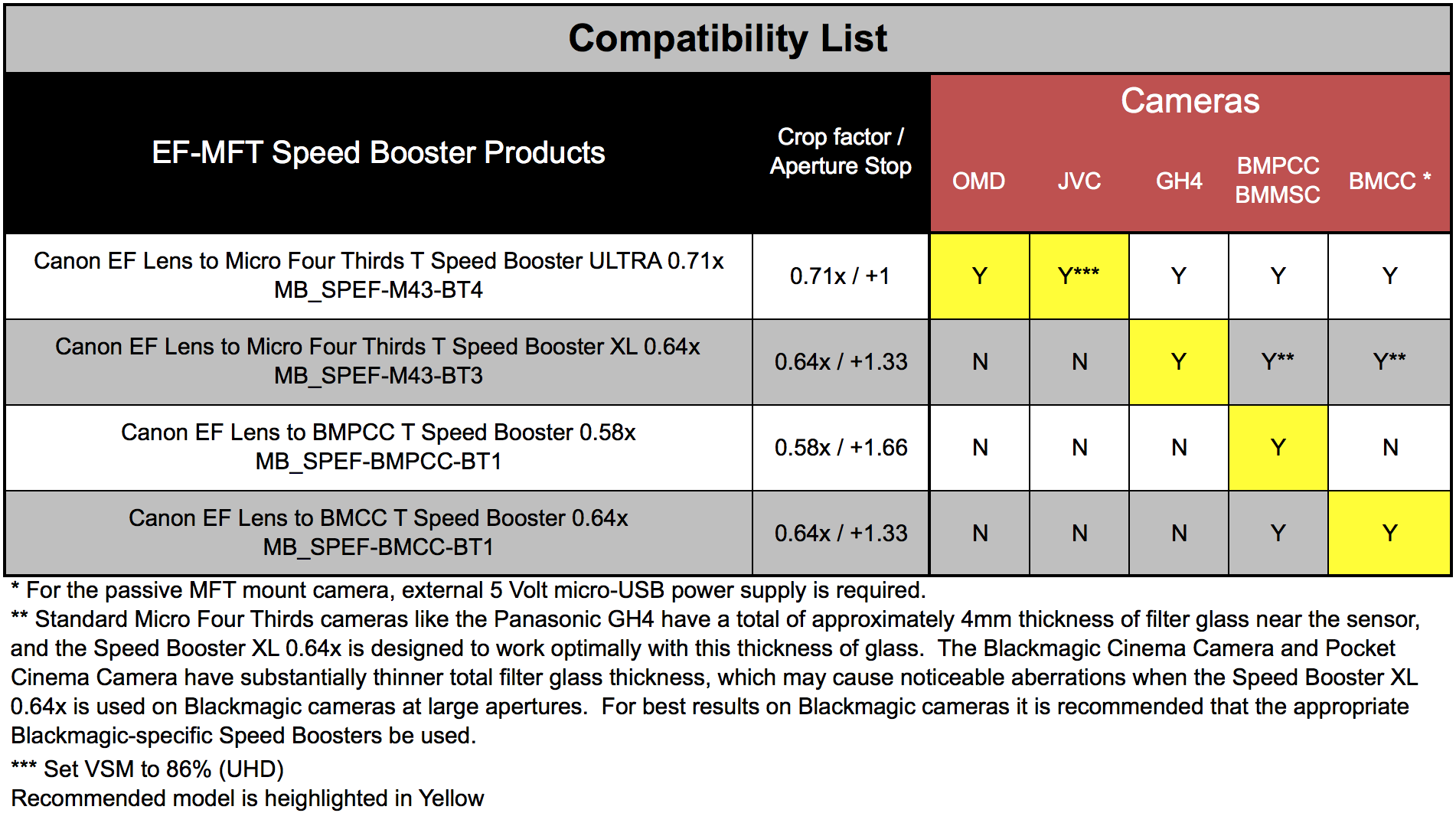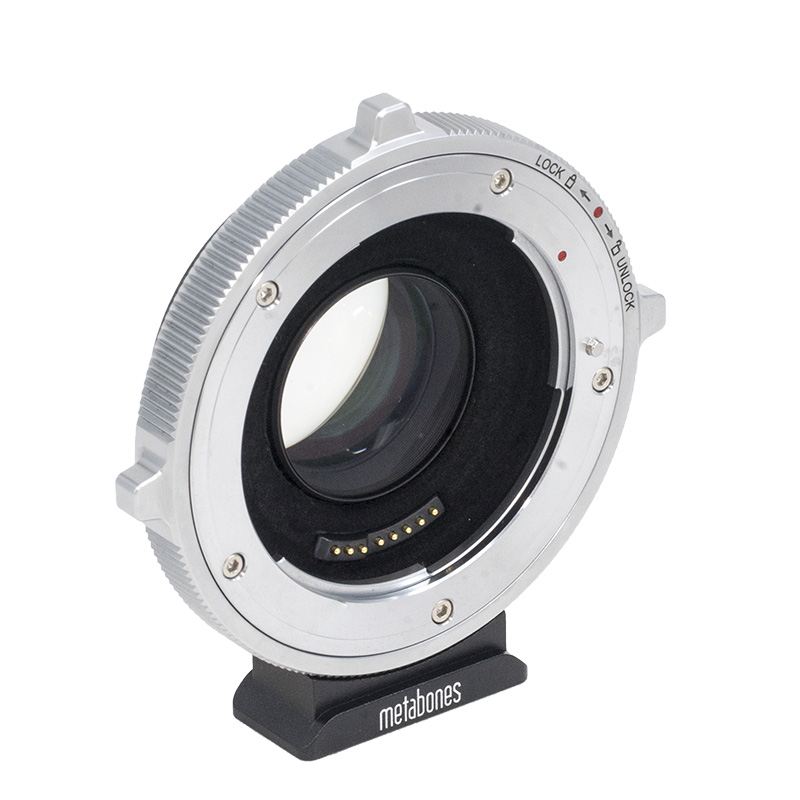Canon EF Lens to Micro Four Thirds T CINE Speed Booster ULTRA 0.71x


Key Features

GH5, XL or ULTRA?
In a nutshell, we recommend XL for full frame lenses and ULTRA for DX/APS-C lenses. For the long story, read the 'limitations' column.
| Features and Benefits |
Limitations |
|
|---|---|---|
|
Optical
Electronic
Other
|
|
Description

Always Enhance and Never Degrade the Performance of the Attached Master Lens
Like the ULTRA series for Sony E-mount, the new Speed Booster ULTRA m43 uses an advanced 5-element 4-group optical design incorporating ultra-high index tantalum-based optical glass. However, the new design is specifically optimized for the Micro Four Thirds sensor and filter stack, and as a result, achieves an astonishing level of performance that sets a new standard for focal reducers.
Like the revolutionary original Metabones Speed Booster® announced in January 2013, the Speed Booster ULTRA m43 has a magnification of 0.71x, and so it effectively reduces the crop factor of mirrorless Micro Four Thirds mount cameras from 2.0x to 1.4x. However, the new ULTRA design makes very effective use of exotic materials at the furthest limit of glassmaking technology, and as a result is almost perfectly corrected for use with all fullframe SLR lenses regardless of aperture. The Speed Booster ULTRA m43 will also work extremely well with many DX and APS-C format lenses provided the image circle of the lens is large enough. Optical performance of the new Speed Boosters is so good that the MTF of any lens attached to it will be improved. Even the latest generation of ultra-high performance SLR lenses such as the Zeiss Otus series can be improved by adding a Speed Booster ULTRA m43. (More information can be found in the press release here and whitepaper here)
Autofocus with an Optimum Balance of Accuracy, Speed, Consistency and Reliability
New in Speed Booster ULTRA for Canon EF Mount to Micro Four Thirds is autofocus support, subject to certain limitations (see table above for details). We are pleased to report that Panasonic Micro Four Thirds camera bodies are capable of autofocusing accurately even if the maximum aperture of the Speed Booster and the lens combined is in the sub-f/1.0 range. Although our first and foremost priority is accuracy, we are able to make great strides in autofocus speed as well.
Select the correct EF-MFT Speed Booster for your camera

Camera Body Compatibility List
Blackmagic: Micro Cinema Camera, Pocket Cinema Camera
JVC: GY-LS300
Olympus: E-M1, E-M1 Mark II, E-M5, E-M5 Mark II, E-M10, PEN-F, E-P5, E-PL3
(Incompatible with OM System OM-1 due to the physical interference between the adapter and camera body)
Panasonic: GX1, GX7, GX8, GX80/85, GH1, GH4, GH5, GH5s, GH5 II, GH6, GH7, G2, G3, G5, G7, G8, G80/85, G9, G9 II, GM1, GF3, AF100
This product does not fit on OM System OM-1.
Unlisted cameras have not been fully tested for compatibility.
Autofocus Lens Compatibility List
The following table lists lenses which has been tested. Other lenses not listed here typically works well, too.
|
Accurate |
Tested by the community, thanks! |
Accurate only on newer cameras such as Panasonic G7, GX8 and GX80/85 |
|
Canon CN-E 18-80mm T4.4 Compact-Servo EF** |
Canon EF 70-200mm f/2.8L IS USM (Mark I) |
Canon EF 70-200mm f/4L USM (non-IS) |
|
Inaccurate |
Require external USB power supply owing to high current consumption; AF inaccurate |
|
|
Canon EF 28-70mm f/3.5-4.5 II |
Tamron 28-300mm f/3.5-6.3 XR Di VC A20 (note 1) |
|
|
Does not fit, even after modification |
Manual focus only |
Not supported |
| Canon EF-S 18-135mm f/3.5-5.6 IS Nano USM |
Contax N lenses modified by Conurus |
Focus confirmation "chips" |
* with smooth iris support
** CN-E Compact-Servo lens with some of MFT cameras may require external power to autofocus
Note 1: VC function of Tamron 28-300/3.5-6.3 XR Di VC model A20 may not operate, due to usually high current requirement.
Manual Focus Lens Compatibility
Some improperly-made M42 screw mount adapters may short the electronic contacts of the Speed Booster and cause damage to the Speed Booster and/or camera body.
Focus confirmation "chips" such as Dandelion are incompatible.
Many manual focus lenses (e.g. OM 28/2.8, OM 50/1.8, Leica R 15/3.5) have rear protrusions (spikes, levers, other appendages) which would damage the optics and/or housing of Speed Booster. They need to be modified before they can be safely used on Speed Booster. Check and make sure there are no rear protrusions from the adapter/lens combination before using on Speed Booster. Scratches and damages caused by rear protrusions on Speed Booster are not covered by warranty.
List of manual focus lenses which REQUIRE MODIFICATION to be used on Speed Booster
Leica RSuper-Elmar-R 15mm |
Nikon F20/2.8 AI-S |
Olympus OMOM 18/3.5 |
Pentax KEvery Pentax K-mount lens has a protruding fin and an aperture lever. It does NOT fit. |
Remark: Your PayPal receipt is your order confirmation. There is no separate email confirmation until shipment takes place.
Disclaimer: we are NOT licensed, approved or endorsed by Micro Four Thirds or Canon.
Why Metabones®?
Since its inception, Metabones has been designing and manufacturing lens adapters recognized among professionals and enthusiasts as leaders in design and workmanship.
Contrary to the popular trend of other factories using an aluminum ring painted black on the camera-body-side, we instead take no short-cut but use precision-machined brass with chromium plating on both the camera-body and the lens sides of our adapters, in order to ensure smooth mounting, great appearance, and durability. The lens side of the adapter features a strong leaf-spring structure, strengthening the adapter-lens connection and ensuring tightness of the lens in order to reduce wear and prevent focus errors and optical alignment issues from appearing.
Metabones uses matte-black treatment to keep internal reflection to a minimum in order to maintain the maximum optical quality possible with the lens.
All Metabones Adapters follow this tradition of uncompromising precision, robust build quality and outstanding finish. Our new Smart AdapterTM series of products add industry-leading electronic interfacing technology from Canada, with true electronic control of the lens' aperture directly from the camera body.
Features
- Both camera-side and lens-side of the adapter are made of brass, precision-machined and plated with chromium.
- Satin surface finish - just like your OEM lens and camera mounts.
- Precise fit and solid connection - lens has no play, gap or wiggling when mounted on adapter and no adjustments are required to fit your lens.
- Designed to reach infinity focus while maintaining the correct registration distance required to maintain optical quality of CRC lenses or lenses with floating elements.
Our Smart AdapterTM series adapters have the following additional features
- True electronic integration of aperture diaphragm - let camera automatically choose aperture in P or S exposure modes, or dial in yourself on the camera body in A or M modes.
- EXIF data such as lens identification, focal length and aperture.




